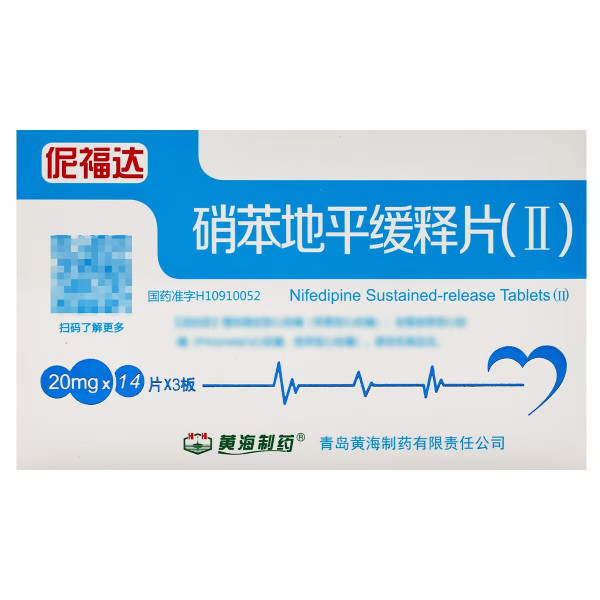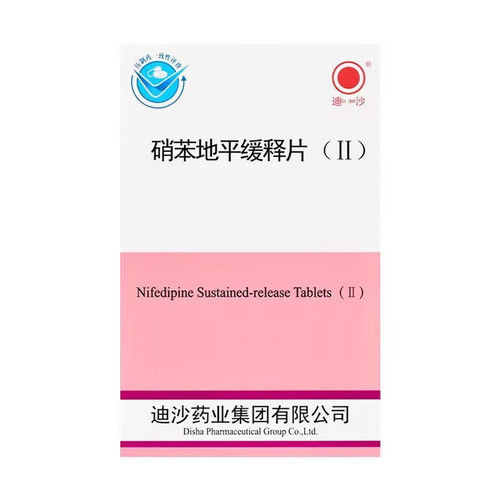Product Overview
[Drug Name]
Generic Name: Nifedipine Sustained-Release Tablets (II)
Trade Name: Nifuda
English Name: Nifedipine Sustained-Release Tablets (II)
Chinese Pinyin: XiaobendipingKongshiPian
[Ingredients]
The main ingredient of this product is nifedipine, whose chemical name is: 2,6-dimethyl-4(2-nitrophenyl)-1,4-dihydro-3,5-pyridinedicarboxylic acid dimethyl ester. Its structural formula is: Molecular formula: C₁ₐH₁₈N₂O₆ Molecular weight: 346.34
[Properties]
This product is a yellow tablet.
[Indications]
For the treatment of hypertension and angina pectoris.
[Dosage and Administration]
Oral administration. Take one tablet once or twice daily, or as directed by a physician.
[Adverse Reactions]
1. Short-lived and most common reactions include swelling of the ankles, feet, and calves, which can be relieved with diuretics. 2. Occasionally, chest pain, headache, flushing, dizziness, palpitations, and low blood pressure may occur. 3. Occasionally, abdominal pain, nausea, loss of appetite, and constipation may occur. 4. Gum hypertrophy may occur.
[Contraindications]
Contraindicated in patients allergic to nifedipine.
[Precautions]
1. This product is a sustained-release tablet. It must be swallowed without chewing. To reduce the dose, the tablet can be split into two halves along the center line. 2. When discontinuing calcium channel blockers, the dosage should be gradually reduced. Do not discontinue the medication without a doctor's instructions. 3. Use with caution in patients with hypotension. 4. Use with caution in patients with severe aortic valve stenosis or hepatic or renal insufficiency.
[Special Use]
Precautions for children: Contraindicated in children.
Precautions for pregnancy and lactation: Contraindicated in pregnant women. Clinical studies in nursing mothers are insufficient. It is best not to breastfeed while taking this product.
Precautions for the elderly: No studies have been conducted and no reliable references are available.
[Drug Interactions]
1. Concomitant use with other antihypertensive drugs may cause extreme hypotension. 2. Concomitant use with beta-blockers may lead to hypotension, depressed cardiac function, and an increased risk of heart failure. 3. Sudden discontinuation of beta-blocker therapy and initiation of this drug may occasionally cause angina pectoris; the dosage of the former should be gradually reduced. 4. Concomitant use with highly protein-bound drugs such as dicoumarol, digitalis glycosides, phenytoin, quinidine, quinine, and warfarin often alters the free concentration of these drugs. 5. Concomitant use with nitrates may enhance the therapeutic effect of angina pectoris.
[Pharmacological Actions]
Nifedipine inhibits calcium ion transport across the membranes of myocardial and vascular smooth muscle, inhibiting the influx of calcium ions into cells, leading to decreased myocardial contractility and vasodilation. Animal studies have shown that it reduces myocardial oxygen consumption by decreasing myocardial contractility and peripheral vascular resistance; increases oxygen supply to ischemic myocardial areas by dilating coronary vessels and promoting collateral circulation; and enhances resistance to hypoxia by inhibiting the consumption of high-energy phosphate compounds.
Storage: Store in a sealed container away from light.
Strength: 20mg
Packaging: 20mg x 42 tablets
Expiry Date: 36 months
Approval Number: National Medicine Standard H10910052
Manufacturer: Qingdao Huanghai Pharmaceutical Co., Ltd.









